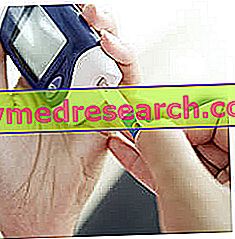Definition and applications
The glucometer (or reflector) is a portable medical device able to estimate the rate of glucose in the blood with a good approximation.

Advantages
Importance of glycemic self-monitoring
- Adjustment of hypoglycemic therapy to the glycemic values shown by the glucometer; this allows you to:
- evaluate the appropriateness of the adopted insulin scheme and the effectiveness over time of the self-administered insulin units (depending on the type and amount of insulin)
- prevent episodes of hypoglycemia and hyperglycemia
- intervene in a targeted and timely manner in situations of poor diabetes control, reducing the extent and frequency of glycemic excursions
- increase safety for oneself and others (think of the risk of suffering a serious hypoglycemic crisis while driving or using machinery)
- overall, to prevent or otherwise delay the appearance of typical diabetes complications
- Patient food and behavioral education
- by critically re-elaborating the glycemic values and putting them in relation to the diet, the level of physical activity and any illnesses in progress (even temporary as the typical winter illnesses), the patient becomes aware of the enormous influence of these factors on glycemic levels. For example, you will notice that a correct diet and constant physical activity allow you to significantly reduce your blood sugar and with it the necessary insulin doses; vice versa, the diabetic will see how psycho-physical stress, certain foods, a sedentary lifestyle and illnesses can raise glycemic values, requiring an increase in the dose of insulin.
In a nutshell, blood glucose self-measurement can tell the diabetic if he is making the right choices about lifestyle and medications, and informing him about the repercussions of such future choices.
Naturally all the advantages deriving from the correct use of the glucometer presuppose the collaboration and the good will of the patient in following the medical indications to the letter.
PLEASE NOTE : glycemic self-monitoring with glucometer, while stimulating self-education and self-correction of insulin doses, CANNOT and should not replace the interaction between diabetologist and sick specialist, a relationship that on the contrary must emerge strengthened by this recommendable practice. For example, the patient should request the advice of the healthcare team to adjust the type and dose of insulin, oral hypoglycemic agents, but also meals or snacks, when it fails to achieve the goals set for good glycemic control.
How it works and how to use it
For blood glucose self-monitoring it is necessary to have a glucometer, a lancing pen with needles and special test strips. Glucometers are usually sold in kits containing these instruments; once the test strips and lancing needles are exhausted you can buy them separately keeping the original glucometer. NOTE: before purchasing it is necessary to check the compatibility of the test strips with the type of meter used, since each model requires a specific type of map.
To estimate glycaemia, the glucose meter analyzes a small drop of capillary blood - generally taken from the fingertip - placed on a special test strip inserted inside it. In most models, the glucose contained in the blood sample will give rise to an enzymatic reaction by oxidizing thanks to the presence of the enzyme glucose-oxidase in the test strip; this oxidation will give rise to a chromatic variation or to an electric current (depending on the model) translated into the corresponding glycemic value.
Let's see in detail which procedures to follow for a correct use of the meter:
- wash your hands with soap and water, and dry them thoroughly
- take a test strip from the container and close it immediately
- insert the test strip in the meter and wait for the instrument to confirm
- gently place a drop of capillary blood on the reactive part (free end) of the strip; this drop of blood is taken through special lancing devices by performing a puncture on a fingertip (before performing the puncture always remember to wash and dry your hands, disinfecting the fingertip). To encourage blood supply and blood flow, it is advisable to gently massage the fingertip before drawing
- Wait for the confirmation of the adequacy of the sample (which may be insufficient or excessive) on the part of the meter and read the measured blood glucose value on the display
- Record the glycemic value in your diary and adjust the therapy as required by your doctor if necessary. Many glucometers allow you to store the values of several tens of glycemic measurements in the internal memory of the device, and transfer them to your computer via a USB cable; still, some models translate these values into graphs showing for example the average daily blood sugar and the amplitude of daily glucose excursions.
NOTE:
- The self-retrieval device and sterile hands should NOT be shared with other people.
- Always use a new, sterile lancet and a new test strip for glucose testing (these are disposable only)
Since this is a general description, and since various automated devices are available on the market, it is recommended that the procedural standards suggested by the manufacturer be carefully observed. The pharmacist or doctor who is treating the patient should also instruct him on the correct methods of use, dispelling any doubts that may arise.
When and how often do you take the measurement?
In general, self-monitoring by test strips is recommended three or four times a day according to the scheme prescribed by the doctor. However, this is a general indication, variable for example based on the type of diabetes (1 or 2) and the pharmacological therapy undertaken.
One of the most widely used schemes is based on four daily glycemic determinations: in the morning on an empty stomach and two hours after each meal (breakfast, lunch and dinner). In certain circumstances it may be useful to use the meter even before lunch and before dinner, perhaps by performing these two additional measurements only in 2-3 days a week.
Always in general, it is advisable to increase the number of glycemic measurements using a glucometer when:
- We practice more physical activity or less physical activity.
- You are sick or stressed
- Changes are made to routine or eating habits, e.g. travelling
- The dose of insulin or medicines is changed or corrected
- Symptoms of hypoglycemia are felt
- Symptoms of hyperglycemia are felt
- You suffer from night sweats or headaches in the morning
Accuracy of results
If carried out in full compliance with the rules of correct use dictated by the manufacturer, the estimate of blood glucose levels through test strips and portable glucometer is particularly accurate. The technological advances of recent years have in fact made it possible to significantly increase the reliability of the measure, even in particular conditions. Among these, the value of hematocrit, which when particularly low (60-65%) could - depending on the model - make the estimate of the concentration of glucose in the blood inaccurate (over-or underestimating it by approximately 10-15%). The same goes for extremely high or extremely low blood sugar levels.
Even the operating temperature is important: an environment that is too cold (40 ° C) could distort the glycemic values returned by the appliance; the same applies to the values of altitude and ambient humidity.
Finally, there may be important differences depending on the type of test strips used, even if produced by the same company and of the same model (possible variation from lot to lot). For this purpose, some glucometers require to insert the code or chip present in the package to self-calibrate based on the characteristics of the test strips used; others are able to detect this data independently. In the event of an automatic procedure (chip insertion or automatic detection) it is however important to make sure that the meter displays the same code shown on the strip packaging. All these calibration operations must be repeated when opening and using a new package of test strips.
For all these reasons, the reliability of the glucometer is acceptable when its use is confined to blood glucose self-monitoring, while it is insufficient as regards the use for the diagnosis of diabetes, IFG (impaired fasting blood glucose) or IGT (reduced glucose tolerance). In other words, the glucose meter should only be used to test blood glucose and only with capillary whole blood samples. It cannot be used for the diagnosis of diabetes.
To improve the accuracy of results
In addition to complying with the rules of correct use provided by the pharmacist, the doctor and the manufacturer, remember:
- wash and dry your hands carefully before using the glucometer
- do not use expired test strips
- use COMPATIBLE test strips with the model of glucometer used
- keep the test strips in a cool place, away from heat, light and excessive environmental humidity
- insert the strip correctly into the glucometer
- take a sufficient sample of blood to be placed on the strip
- clean the meter regularly
- check the status of the batteries and replace them immediately when they are reported as discharged
- make sure the calibration code is correct
It is possible to check the accuracy of all the glucometers with drops of specific liquid for the device, called control solution, when the device or the test strips are deemed not to work properly. They are expensive, have a short life span and once opened, they last only a few months.
Beyond the specific accuracy of the test strips and glucometer used by the patient, it is in any case recommended that self-monitoring be periodically integrated with the analysis of traditional plasma glucose using a hospital sample; in this way it is possible to compare the data and make sure that the glucometer works correctly (for this purpose, carry out the two measurements at the same time and in the state of nutrition, or better yet, self-monitor the blood sugar with a glucometer and test strips immediately before or immediately after the hospital withdrawal ).



